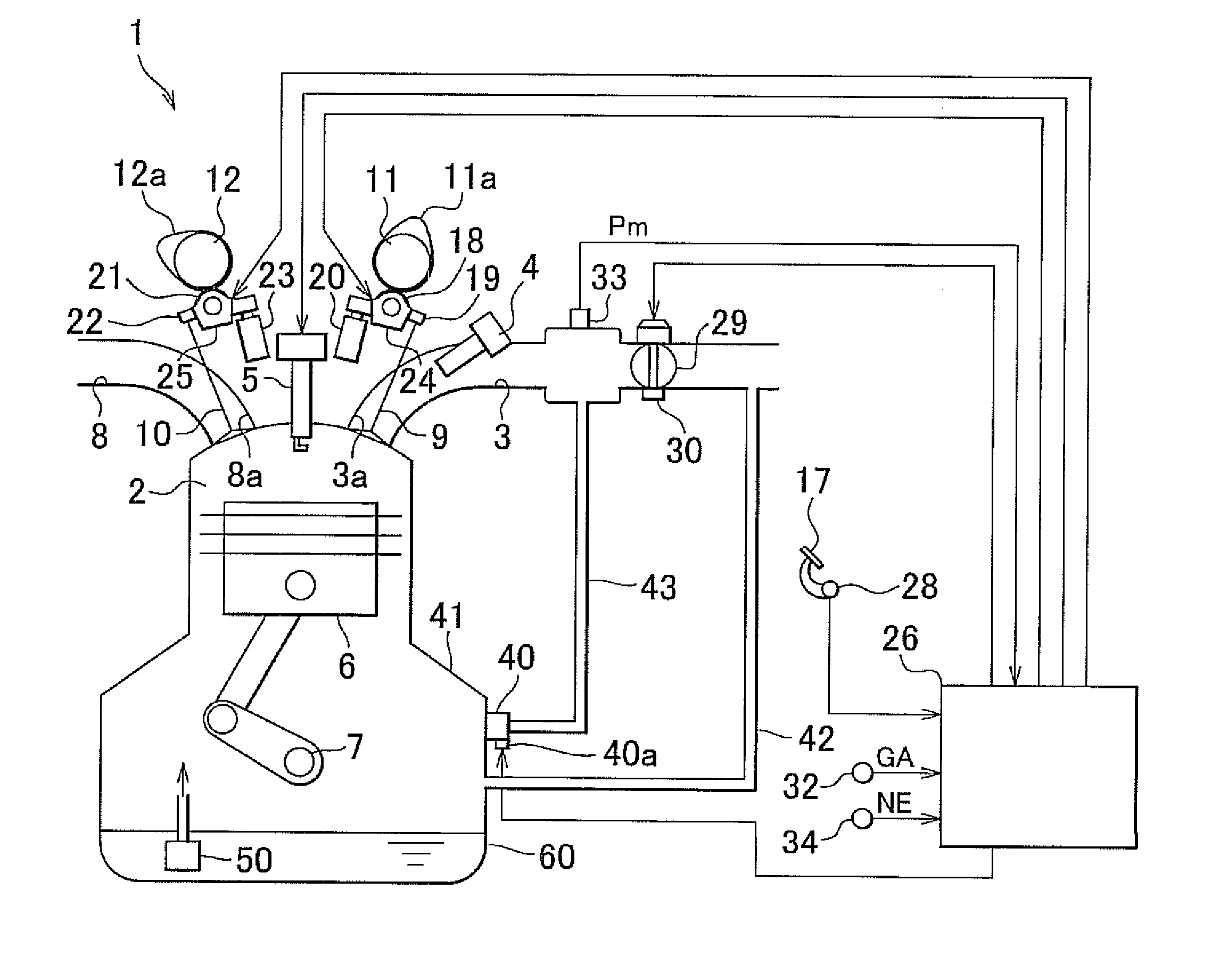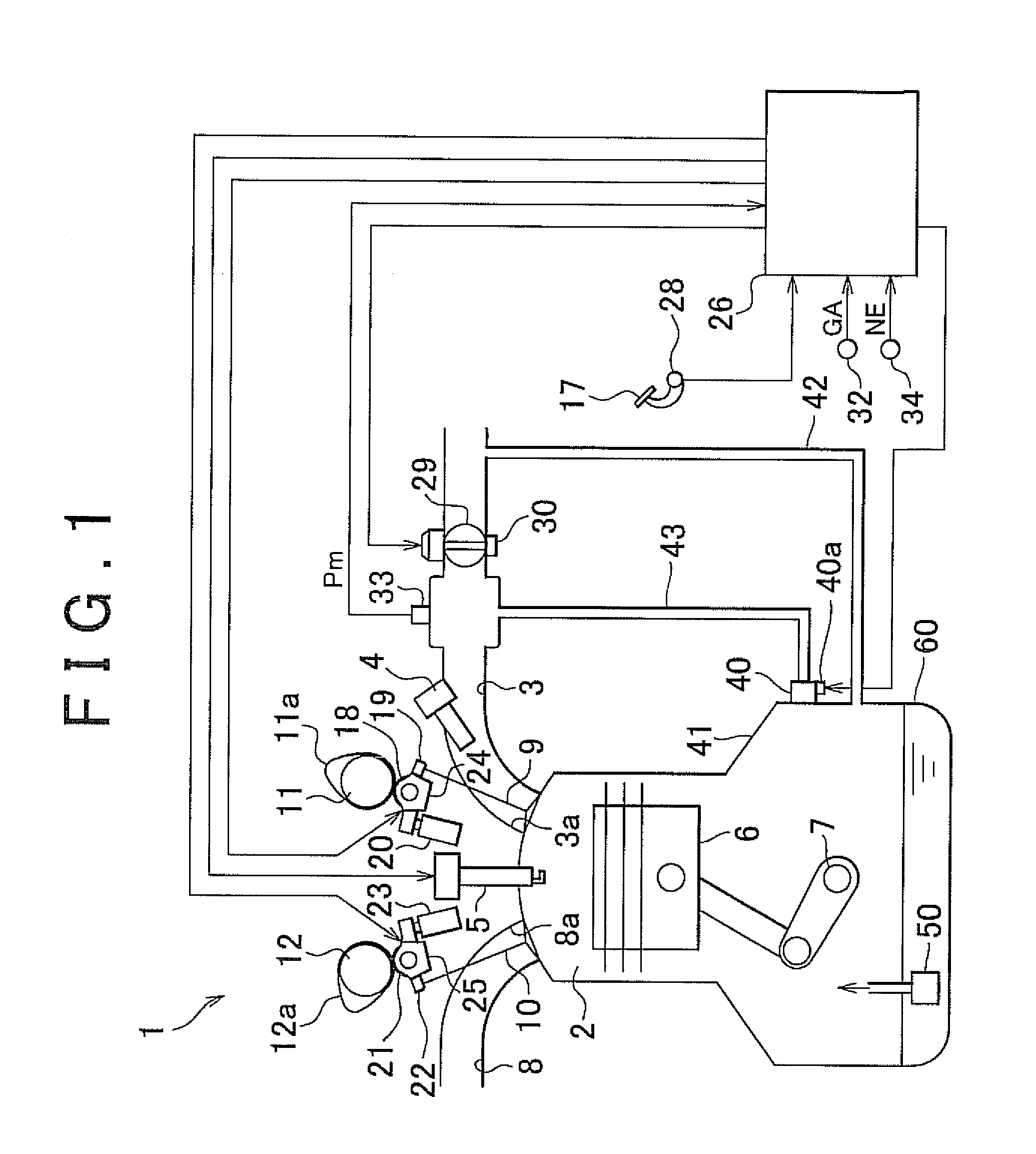Control device for internal combustion engine and control method for internal combustion engine
a control device and internal combustion engine technology, applied in the direction of machines/engines, combustion air/fuel air treatment, output power, etc., can solve the problems of difficult to appropriately control the flow rate of gas, degrade the internal combustion engine, and degrade the engine oil, so as to reduce the number of operating cylinders
- Summary
- Abstract
- Description
- Claims
- Application Information
AI Technical Summary
Benefits of technology
Problems solved by technology
Method used
Image
Examples
first embodiment
[0036]Hereinafter, a control device for an internal combustion engine according to the invention will be described with reference to FIG. 1 to FIG. 4.
[0037]An engine 1 shown in FIG. 1 is a multi-cylinder internal combustion engine having a plurality of cylinders. By adjusting the opening degree of a throttle valve 29 provided in an intake passage 3 of the engine 1 on the basis of an amount by which an accelerator pedal 17 is depressed (accelerator operation amount), or the like, air of an amount corresponding to the opening degree of the throttle valve 29 is supplied to a combustion chamber 2 of each cylinder via the intake passage 3. In addition, fuel of an amount corresponding to the intake air amount of the engine 1 is injected and supplied from a fuel injection valve 4 to the intake passage 3 of the engine 1. As a result, an air-fuel mixture formed of air and fuel fills the combustion chamber 2 of each cylinder in the engine 1. As the air-fuel mixture is ignited by an ignition p...
second embodiment
[0067]Next, a control device for an internal combustion engine according to the invention will be described with reference to FIG. 5.
[0068]As described above, in the engine 1 with the cylinder cut-off mechanism, the intake pressure Pm in the intake passage 3 varies on the basis of the number of operating cylinders. Then, in the first embodiment, the intake pressure Pm is detected, and then the opening degree V of the PCV valve 40, corresponding to the required flow rate DE, is variably set on the basis of the detected intake pressure Pm.
[0069]On the other hand, in the second embodiment, in the engine 1 with the cylinder cut-off mechanism, the opening degree V of the PCV valve 40, corresponding to the required flow rate DE, is variably set on the basis of the number of operating cylinders. Then, part of the opening degree setting process in the second embodiment differs from that of the first embodiment, and the intake pressure sensor 33 is omitted in the second embodiment. Then, her...
third embodiment
[0076]Next, a control device for an internal combustion engine according to the invention will be described with reference to FIG. 6 to FIG. 9.
[0077]The third embodiment differs from the first embodiment in that a variable valve mechanism that varies the valve characteristic of each intake valve 9 is provided instead of the cylinder cut-off mechanism, the intake pressure sensor 33 is omitted and part of the opening degree setting process for the PCV valve 40 is changed. Then, hereinafter, the control device according to the third embodiment will be described focusing on the above difference.
[0078]FIG. 6 shows the configuration of the engine 1 according to the third embodiment. As shown in FIG. 6, the engine 1 includes a variable valve lift mechanism 14 as the variable valve mechanism that varies the valve characteristic of each intake valve 9. The variable valve lift mechanism 14 is provided between the intake camshaft 11 and each rocker arm 19, and is driven by an electric motor 15...
PUM
 Login to View More
Login to View More Abstract
Description
Claims
Application Information
 Login to View More
Login to View More - R&D
- Intellectual Property
- Life Sciences
- Materials
- Tech Scout
- Unparalleled Data Quality
- Higher Quality Content
- 60% Fewer Hallucinations
Browse by: Latest US Patents, China's latest patents, Technical Efficacy Thesaurus, Application Domain, Technology Topic, Popular Technical Reports.
© 2025 PatSnap. All rights reserved.Legal|Privacy policy|Modern Slavery Act Transparency Statement|Sitemap|About US| Contact US: help@patsnap.com



